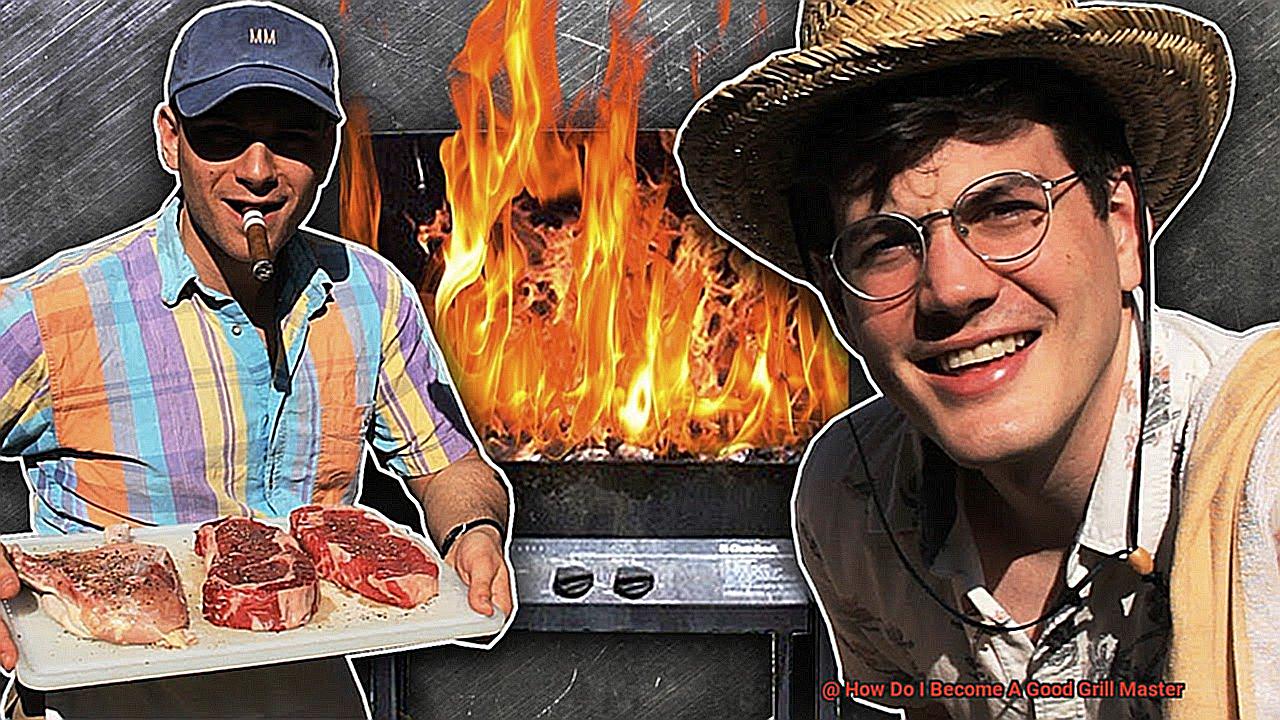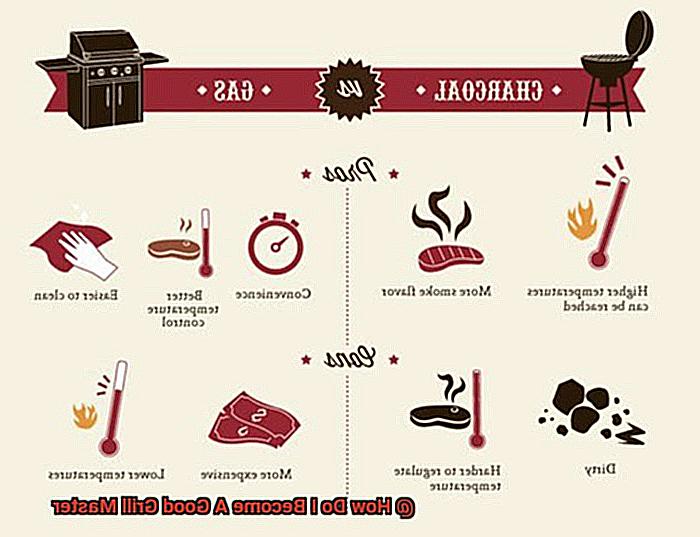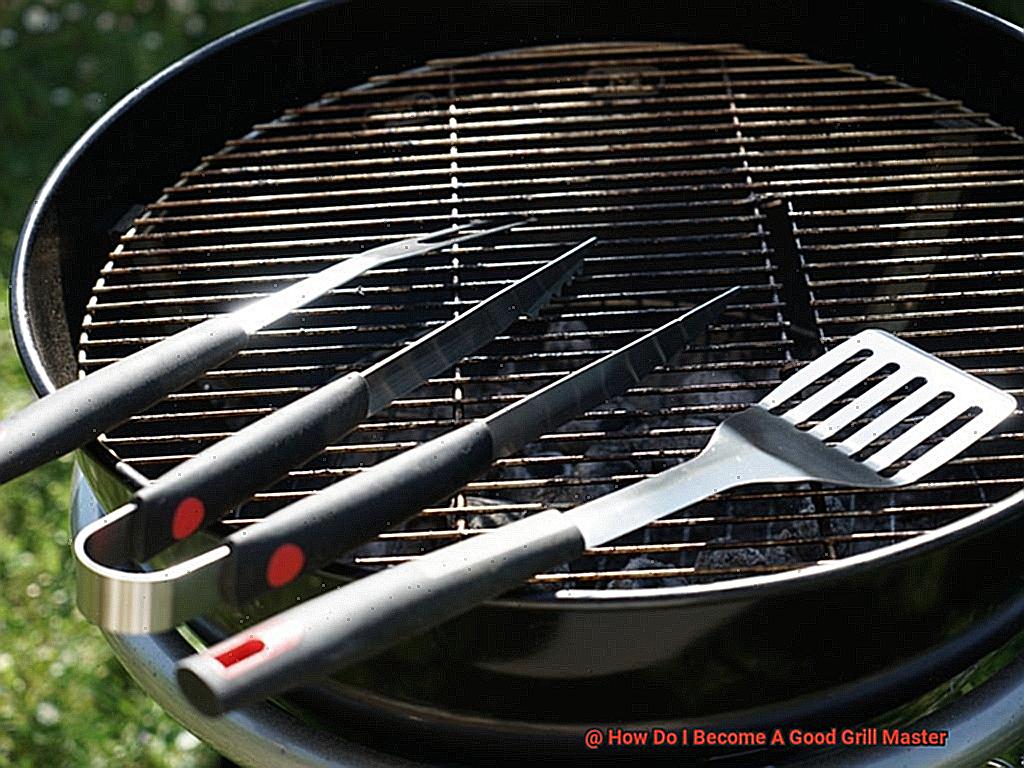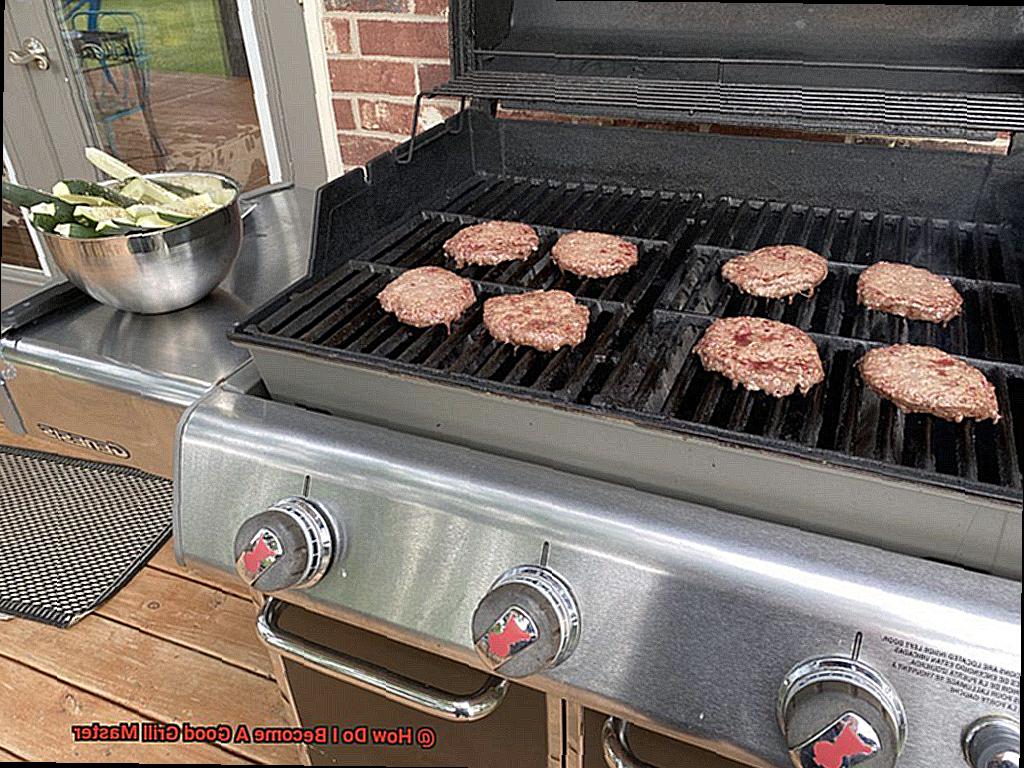Imagine this: a warm summer night, surrounded by loved ones, as the tantalizing scent of perfectly grilled food fills the air. The sizzle of juicy steaks, vibrant veggies, and mouthwatering seafood creates an atmosphere that’s simply unmatched by any other cooking method. Whether you’re a grilling newbie or someone looking to take their skills to new heights, this blog post is here to guide you on your journey to becoming a true grill master.
We’ll start from scratch, covering the basics of grilling and then diving into advanced techniques that will set you apart from the rest. So grab those tongs, fire up the coals, and let’s embark on this flavorful adventure together as we uncover the secrets to becoming a grill master extraordinaire.
Contents
Types of Grills Available
Let’s explore the different types of grills and their unique features:

- Charcoal Grills: Charcoal grills are a timeless classic that offer a distinct smoky flavor to your food. They use charcoal briquettes or lump charcoal as fuel, which can reach high temperatures quickly, making them perfect for searing meats. Charcoal grills also provide versatility in cooking methods, allowing for both direct and indirect cooking.
- Gas Grills: Gas grills are known for their convenience and ease of use. They are powered by propane or natural gas and ignite with just the push of a button. Gas grills offer precise temperature control, allowing you to cook your food evenly and efficiently. They are also easy to clean and maintain compared to charcoal grills.
- Electric Grills: Electric grills are a popular choice for those who live in apartments or have limited outdoor space. These grills are powered by electricity and heat up quickly, making them ideal for quick meals. Electric grills provide even heat distribution and easy temperature control, making them user-friendly for beginners.
- Pellet Grills: Pellet grills have gained popularity in recent years due to their ability to infuse food with a delicious smoky flavor. These grills use wood pellets as fuel and operate similarly to convection ovens, maintaining a consistent temperature throughout the cooking process. Pellet grills offer versatility, allowing you to grill, smoke, bake, roast, and even braise your favorite dishes.
- Kamado Grills: Kamado grills originated in Japan and are characterized by their excellent heat retention capabilities. Made from ceramic or clay, these grills have an egg-shaped design that helps maintain consistent temperatures for extended periods. Kamado grills can be used for various cooking methods, including grilling, smoking, baking, and even pizza-making.
- Portable Grills: For those who enjoy grilling on the go or need a compact option for picnics or camping trips, portable grills are the perfect choice. These grills come in various sizes and fuel options, including charcoal, gas, and electric. Despite their compact size, portable grills still deliver excellent cooking performance.
When choosing a grill, it’s important to consider factors such as cooking space, fuel type, temperature control, and portability. Each type of grill offers its own unique advantages and features, so take your time to find the one that suits your needs best.
Different Methods of Grilling
Grilling, a beloved cooking method that imparts delicious flavors and mouthwatering aromas to food, offers a variety of techniques to explore. Whether you are a seasoned grill master or just starting out, understanding the different methods of grilling can take your culinary skills to new heights and impress your family and friends with delectable dishes.
The first method to consider is direct grilling. This technique involves placing the food directly over the heat source, such as charcoal or gas flames. Direct grilling is perfect for foods that cook quickly, such as juicy burgers, succulent steaks, and vibrant vegetables. The high heat sears the outside of the food, creating a tantalizing caramelized crust while keeping the inside tender and juicy.
On the other hand, indirect grilling takes a different approach. In this method, the food is placed away from the direct heat source, allowing for slower cooking. Indirect grilling is ideal for larger cuts of meat, like whole chickens or savory roasts. By cooking the food indirectly, you can ensure even cooking throughout without worrying about burning the exterior.

For those seeking an infusion of smoky flavors, smoking is an excellent choice. Smoking involves cooking the food slowly over low heat and adding wood chips or chunks to create aromatic smoke. This method is perfect for meats like succulent ribs or flavorful brisket, as the smoke permeates the food, resulting in a distinctive taste sensation.
If you crave something out of the ordinary, consider trying rotisserie grilling. Skewering the food onto a rotisserie spit and slowly cooking it as it rotates produces juicy and tender meat. Rotisserie grilling is particularly well-suited for large cuts of meat like whole chickens or mouthwatering roasts.
To achieve mastery in each grilling method, it’s crucial to understand how to use them correctly. Direct grilling requires controlling temperature and timing to avoid overcooking or undercooking. Indirect grilling demands setting up your grill for two-zone cooking, with the heat source on one side and the food on the other. Smoking requires maintaining a low and steady temperature for an extended period, while rotisserie grilling mandates securing the food properly on the spit and ensuring even rotation.
In addition to the different methods of grilling, there is a wide range of grill types available on the market. Charcoal grills offer that timeless smoky flavor but require more effort to set up and control temperature. Gas grills provide convenience and precision, allowing easy adjustment of heat levels. Electric grills are compact and portable, perfect for small spaces or outdoor gatherings. Pellet grills offer versatility, enabling smoking, grilling, baking, or roasting with ease. Inspired by traditional Japanese clay ovens, Kamado grills provide excellent heat retention and can reach high temperatures for searing.
By mastering these different methods of grilling and understanding how to use each type of grill effectively, you can elevate your grilling game and create a wide range of incredible dishes. Whether you’re cooking up a sizzling steak on a gas grill or slow-smoking ribs on a charcoal grill, experimenting with different techniques allows you to explore new flavors and expand your culinary skills.
Controlling the Temperature
Controlling the temperature on your grill is a skill that separates the amateurs from the grill masters. It’s the difference between a perfectly cooked steak and a disappointing, overcooked piece of meat. But fear not, because I have compiled some key tips and techniques to help you become a temperature control ninja.
First and foremost, preheating your grill is crucial. This step ensures that your cooking grates and the interior of your grill are at the desired temperature before you start cooking. It not only prevents sticking but also promotes even cooking. So take the time to preheat your grill according to the instructions in your grill’s manual.
Now, let’s talk heat zones. Your grill has different zones of heat, each serving a specific purpose. Direct heat is where the flames or heat source are located, perfect for searing those juicy steaks. Indirect heat is away from the flames, ideal for slow and gentle cooking. And don’t forget about the warming zone, which keeps your cooked food warm without continuing to cook it.
To control the temperature, you need to know how to adjust your grill’s vents or burners. Vents are like the lungs of your charcoal grill, regulating airflow and therefore temperature. Opening them allows more oxygen in, increasing the heat, while closing them restricts airflow and lowers the temperature. With gas grills, you can adjust the flame intensity using burner controls.
Speaking of charcoal grills, arranging your coals can also help you manipulate the temperature. Piling them together creates high heat for intense searing. Spreading them out evenly produces medium heat for even cooking. And if you want a low-temperature indirect cooking zone, create two separate piles with an empty space in the middle.

Different foods require different cooking temperatures. Thick cuts of meat benefit from high heat to sear the outside while keeping the inside juicy. Delicate foods like fish or vegetables may require lower heat to prevent burning or overcooking. So consult a recipe or grilling guide to find the optimal temperature for your specific dish.
Last but not least, invest in a reliable thermometer. This tool ensures that you’re cooking your food to the perfect internal temperature. Insert the probe into the thickest part of the meat for accurate readings. And remember, the internal temperature will continue to rise slightly after removing the food from the grill, so it’s best to remove it a few degrees below your target temperature.
Different Cuts of Meat and Ideal Cooking Times
Grilling is an art that requires more than just a hot grill and a hope for the best. It demands a deep understanding of different cuts of meat and their ideal cooking times to create perfectly cooked, juicy, and flavorful results. So, let’s journey into the realm of meat cuts and their corresponding cooking times to unlock the secrets of the grill.
First on our list are the glorious steaks. Ribeye, sirloin, and filet mignon reign supreme as the top choices for grilling enthusiasts. Ribeye captivates with its exquisite marbling and rich flavor, while sirloin offers a harmonious balance of tenderness and taste. Filet mignon, the tenderest cut of all, boasts a delicate flavor that is simply heavenly. To achieve medium-rare perfection, sear these beauties for 4-6 minutes per side, adjusting the time based on their thickness.
Pork chops take center stage as a classic grilling choice. Cook them to an internal temperature of 145°F (63°C) for medium doneness, which typically takes about 4-5 minutes per side on a medium-high heat grill. Allow their succulent flavors to dance on your taste buds as you savor each tender bite.
Next in line are chicken breasts, a popular option that requires some finesse to prevent dryness. Aim for an internal temperature of 165°F (74°C) and cook them for approximately 6-8 minutes per side on medium heat. Let these perfectly cooked breasts become the star of your grilling repertoire.

Fish fillets, such as salmon or tuna, demand delicate handling due to their quick cooking nature. Give them 3-5 minutes per side on medium-high heat until they reach an internal temperature of 145°F (63°C). Watch as these ocean treasures transform into melt-in-your-mouth delights that will leave you longing for more.
While we now know the ideal cooking times, various factors can influence them. The thickness of the meat plays a significant role, as thicker cuts require longer cooking times. Additionally, personal preference for doneness level is crucial. If you prefer a rare steak, it will take less time than if you desire it well-done. Furthermore, the intensity of heat on your grill may vary, so adjust your cooking times accordingly to achieve perfection.
Although cooking times provide a helpful guideline, it is always best to rely on a trusty meat thermometer to ensure flawless doneness. Insert the thermometer into the thickest part of the meat without touching bone or fat. The recommended internal temperatures mentioned earlier serve as your guiding light to guarantee both safety and delectable results.
Remember, after grilling, allow your meat to rest for a few minutes before serving. This allows the juices to redistribute within the meat, resulting in an explosion of succulence and flavor that will have your guests raving about your culinary prowess.
To elevate your grilling game to new heights, consider marinating your meat before grilling. This will not only infuse it with tantalizing flavors but also enhance its tenderness. Experiment with different marinades and seasonings to find your perfect combination that will transport your taste buds to paradise.
Preparing Food Before Grilling
Grilling is not just about throwing meat on a hot flame – it’s an art form that requires careful preparation to create mouthwatering dishes. To become a true grill master, it is crucial to understand the importance of preparing food before grilling.
This step sets the foundation for a delicious and well-cooked meal that will leave your guests craving for more. Let’s dive into the key aspects of food preparation before grilling: choosing the right cuts of meat, marinating and seasoning, proper thawing, trimming excess fat, preparing vegetables and fruits, preheating the grill, and having the necessary tools ready.
The first step in preparing food for grilling is choosing the right cuts of meat. Opt for fresh, high-quality cuts that are suitable for grilling. Some popular choices include juicy steaks, succulent chicken breasts, flavorful pork chops, and delectable seafood. High-quality ingredients are essential for achieving outstanding results.
Once you have the perfect cuts of meat, it’s time to enhance their flavors through marinating or seasoning. Creating a flavorful marinade or rub can take your grilled dishes to the next level. Experiment with different combinations of herbs, spices, oil, and acidic ingredients like vinegar or citrus juice to find your favorite flavors. Allow the meat to marinate for at least 30 minutes or up to overnight in the refrigerator.
This process not only adds a burst of taste but also tenderizes the meat, resulting in a juicy and mouthwatering final product. If you’re short on time, a simple seasoning with salt, pepper, and other spices can still elevate the flavors. Remember to season both sides of the meat evenly for optimal taste.
In addition to seasoning, it’s crucial to ensure that the meat is properly thawed if using frozen ingredients. Thawing meat in the refrigerator overnight is the safest method as it prevents bacterial growth. Avoid thawing on the countertop as it can lead to uneven thawing and potential foodborne illnesses. Properly thawed meat cooks more evenly and reduces the risk of undercooked or overcooked portions.
Trimming excess fat from the meat before grilling is another important aspect of food preparation. This not only prevents flare-ups and reduces the risk of burning but also ensures that the flavors are not overshadowed by excessive fat. However, leaving some fat can add flavor and juiciness to the final dish. Strike a balance between trimming excess fat and keeping enough to enhance the taste of your grilled masterpiece.
It’s not just about the meat – vegetables and fruits can also be prepared before grilling to add variety and freshness to your meal. Clean and slice them into even-sized pieces to ensure even cooking. Brushing them with a light coating of oil can help prevent sticking and add flavor. Grilled veggies and fruits can bring a delightful charred sweetness to your plate.
Before you fire up the grill, don’t forget to preheat it properly. Preheating is crucial for achieving a good sear and locking in flavors. Follow the manufacturer’s instructions for preheating your specific type of grill. This process usually takes around 10-15 minutes, allowing the grill grates to reach the desired temperature.
Lastly, make sure you have all the necessary grilling tools and equipment ready before you start cooking. Long-handled tongs, spatulas, a meat thermometer, and a basting brush are essential for a successful grilling session. Having everything within reach will make the grilling process more efficient and enjoyable.
Mastering Proper Grilling Techniques
Mastering proper grilling techniques is a journey that requires knowledge, practice, and a love for the art of grilling. Whether you’re a beginner or an experienced griller, understanding the fundamentals and honing your skills will elevate your grilling game to new heights. Here’s a comprehensive guide to help you become a grill master:
Choosing the Right Grill:
- Gas Grills: Ideal for beginners, gas grills offer convenience, precise temperature control, and quick heating.
- Charcoal Grills: Preferred by grill enthusiasts for their smoky flavor, charcoal grills provide high heat for searing and lower temperatures for slow cooking.
- Electric Grills: Perfect for those with limited outdoor space, electric grills are easy to use but lack the authentic smoky flavor.
Controlling Heat:
- Preheating the Grill: Ensure your grill reaches the desired temperature and prevents food from sticking to the grate by preheating it before cooking.
- Direct and Indirect Heat Zones: Create different heat zones on the grill to cook food at different temperatures simultaneously. This allows for searing in a hot zone while slow cooking in a cooler zone.
Cooking Methods:
- Direct Grilling: Cook food directly over the heat source for a crispy exterior and juicy interior. Perfect for steaks, burgers, and quick-cooking vegetables.
- Indirect Grilling: Place food away from the direct heat source and utilize convection cooking for slower, more even cooking. Ideal for larger cuts of meat like ribs or whole chickens.
- Smoking: Add a rich, smoky flavor to your food by cooking it over indirect heat and using wood chips or chunks to produce smoke. Popular for ribs, briskets, and fish.
- Rotisserie Grilling: Skewer food on a rotating spit to cook it slowly and evenly. Excellent for roasts, whole chickens, and even vegetables.
Flipping and Moving Food:
Practice and Experimentation:
Experimenting With Flavors and Ingredients
Experimenting with flavors and ingredients is a crucial aspect of becoming a good grill master. It allows you to unleash your creativity and elevate your grilling game to new heights. By exploring different flavor combinations and incorporating unique ingredients, you can add depth and complexity to your dishes, leaving your guests impressed and craving for more.
One key reason why experimenting with flavors and ingredients is essential for becoming a good grill master is that it helps you understand the basic flavor profiles and how they can be enhanced through grilling. Incorporating sweet, sour, salty, and bitter flavors into your marinades, rubs, or sauces creates a well-balanced dish that tantalizes the taste buds. For example, a sweet and tangy barbecue sauce made with brown sugar, ketchup, vinegar, and spices adds a delightful contrast to smoky grilled meats.
Another reason to experiment with flavors and ingredients is to explore the vast world of herbs and spices. Rosemary, thyme, cilantro – these herbs add freshness and aroma to your marinades or rubs. Cumin, paprika, chili powder – these spices bring warmth and complexity to your grilled meats. Mix and match these ingredients to find the perfect combination that suits your palate.
Furthermore, don’t limit yourself to traditional grilling ingredients. Think outside the box and explore unconventional options that can take your grilling experience to the next level. Incorporate fruits like pineapple or peaches into your grilling repertoire. Grilling these fruits caramelizes their natural sugars and adds a smoky undertone that complements savory dishes beautifully.
Experimenting with flavors and ingredients also requires an understanding of balancing flavors. Ensure that no single flavor overpowers the others. Balance is key to achieving a harmonious blend of tastes. Pair bold and spicy rubs with cooling and creamy sauces to balance out the heat. Add acidity like lemon juice or vinegar to sweeter marinades for a well-rounded flavor profile.
Lastly, don’t forget the power of marinating and brining your meats before grilling. This step allows flavors to penetrate deep into the meat, resulting in a more flavorful and tender end product. Experiment with different marinades and brines to discover your favorite combinations – tangy citrus marinades for chicken, savory beer brines for pork. Marinating and brining can elevate your grilling game to new heights.
Practicing and Patience
Practicing and patience are essential qualities for anyone striving to become a successful grill master. Just like any other skill, mastering the art of grilling takes time, dedication, and a willingness to learn from mistakes. It is crucial to understand that proficiency in grilling can only be achieved through practice and a patient approach.
To begin, it is important to familiarize yourself with your grill and its various components. Take the time to read the instruction manual thoroughly so that you can operate and maintain your grill correctly. This will ensure that you are using your grill to its full potential and achieving optimal results.
Next, embrace the spirit of experimentation by trying out different meats, vegetables, and marinades on your grill. Grilling is not limited to just burgers and hot dogs; there is a vast range of ingredients that can be cooked to perfection on a grill. Consider grilling chicken, steaks, fish, or even fruits like pineapple or peaches. This will allow you to understand how different ingredients respond to heat and how to achieve the desired outcomes.
Furthermore, investing in a good meat thermometer is essential. Grilling requires precision, and knowing when your food is perfectly cooked is crucial. A reliable meat thermometer will enable you to determine the internal temperature of your meat accurately. This ensures that it is safe to eat and cooked exactly to your preference.
In addition to practicing various recipes and techniques, exercising patience during the grilling process is vital. It is important to resist the urge to constantly flip or move your food around on the grill. Allow it to cook undisturbed for a specific period before checking for doneness or flipping it over. This practice allows for proper caramelization and creates those desirable grill marks on your food.
Moreover, refrain from frequently opening the grill lid to check on the progress of your food. Each time you open the lid, you release heat, which can significantly affect cooking times and result in unevenly cooked food. Instead, rely on visual cues or use your thermometer to determine when your food is ready.
Lastly, embrace the learning process and view mistakes as opportunities for growth. Grilling is a continuous journey of improvement, and even the most experienced grill masters make errors. If a dish does not turn out as expected, take note of what went wrong and make adjustments for the next time. Each grilling session presents a chance to enhance your skills and techniques.
VeWLTjZY8i8″ >
Conclusion
Becoming a skilled grill master requires practice, knowledge, and a passion for cooking over an open flame.
By honing your skills and understanding the art of grilling, you can elevate your barbecue game to new heights. Experiment with different cuts of meat, marinades, and seasonings to create mouthwatering flavors that will impress your friends and family.
Take the time to learn about temperature control, proper grilling techniques, and the importance of letting meat rest before serving. Embrace the sizzle of searing steaks, the smoky aroma of grilled vegetables, and the crackle of a perfectly charred burger.
With dedication and a willingness to learn, you can become a true grill master – commanding the grill with confidence and creating unforgettable meals that will leave everyone wanting more.






